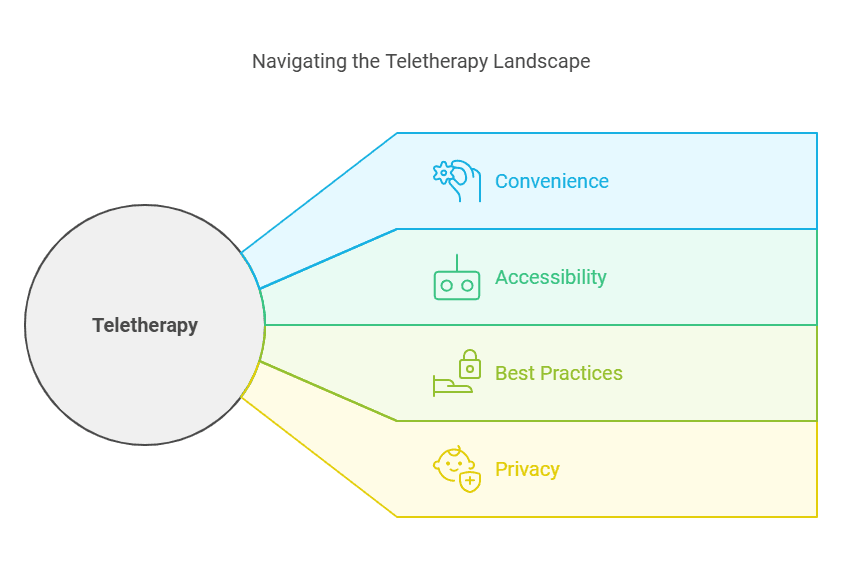The digital age has ushered in a new era for mental health services, with teletherapy becoming an essential mode of treatment. This shift offers unparalleled convenience and accessibility, allowing therapists to reach clients who might otherwise face barriers to receiving care. However, the transition from traditional in-person therapy to virtual sessions requires careful attention to best practices that ensure both effectiveness and privacy. In this comprehensive guide, we will explore key strategies for setting up teletherapy sessions effectively and ensuring privacy throughout these interactions.

Understanding Teletherapy
Teletherapy involves delivering psychological services via digital platforms such as video conferencing tools or phone calls. It provides flexibility for both therapists and clients but also presents unique challenges that must be addressed to maintain high-quality care.
Setting Up Teletherapy Sessions Effectively

1. Choose the Right Platform
Selecting a reliable platform is foundational for successful teletherapy sessions. Opt for platforms specifically designed for healthcare providers that offer secure communication channels compliant with regulations like HIPAA (Health Insurance Portability and Accountability Act). Popular choices include Zoom Healthcare Edition, Doxy.me, and VSee.
2. Create a Professional Environment
The environment you conduct your session from should mimic an in-office experience as closely as possible:
- Quiet Space: Ensure your space is free from distractions such as background noise or interruptions.
- Professional Background: Use neutral backgrounds without clutter; consider using virtual backgrounds if necessary.
- Good Lighting: Proper lighting enhances video quality—natural light works well but avoid backlighting which can obscure facial expressions.
3. Test Technology Beforehand
Technical glitches can disrupt therapeutic rapport significantly:
- Conduct test runs before initial appointments with new clients.
- Familiarize yourself thoroughly with all features offered by chosen software applications (e.g., screen sharing).
4. Establish Clear Communication Protocols
Set expectations early regarding how sessions will proceed:
- Discuss preferred methods of contact outside scheduled appointments (email vs text).
- Clarify procedures if technical issues arise during live meetings—having backup plans ensures continuity even when problems occur unexpectedly.
5. Prepare Clients Thoroughly
Help clients feel comfortable navigating technology:
- Provide detailed instructions on accessing the platform prior to their first session.
- Offer practice run-throughs especially useful for those unfamiliar with digital interfaces.
6. Maintain Engagement During Sessions
Keeping clients engaged remotely may require additional effort compared traditional settings:
- Utilize interactive tools available within platforms like shared documents whiteboards enhance collaboration
7 . Incorporate Feedback Regularly
Gathering feedback allows continuous improvement process
- Encourage open dialogue about what’s working well areas could improve upon
Ensuring Privacy in Teletherapy Sessions
1 . Understand Legal Requirements
Compliance legal standards paramount protecting client information
Overview HIPAA regulations related specifically telehealth
State-specific laws practitioners should aware
2 Implement Security Measures Devices/Platforms Used During Sessions
Protecting data critical maintaining trust relationship between therapist client
Enabling encryption features available within chosen software applications
Regular updates antivirus protection firewalls
3 Educate Clients About Their Role Protecting Privacy
Empowering them take active steps safeguarding own information
Encouraging use secure networks avoid public Wi-Fi connections whenever possible
Advising against sharing personal details third parties unless absolutely necessary
4 Document Consent Thoroughly
Obtaining informed consent crucial aspect ethical practice regardless medium delivery service
Clearly outline terms conditions associated engaging digitally including potential risks limitations compared face-to-face interactions
5 Monitor Developments Field Stay Updated
Keeping abreast latest advancements technologies policies helps adapt changing landscape proactively rather reactively
Joining professional organizations attending webinars conferences valuable resources staying informed emerging trends best practices
Conclusion
As teletherapy continues reshape future mental health care industry adopting effective secure approaches paramount success both practitioners recipients alike By implementing outlined strategies professionals position themselves deliver exceptional service while fostering safe supportive environments conducive healing growth Ultimately embracing evolving nature therapy opens doors greater accessibility innovation benefiting countless individuals worldwide




